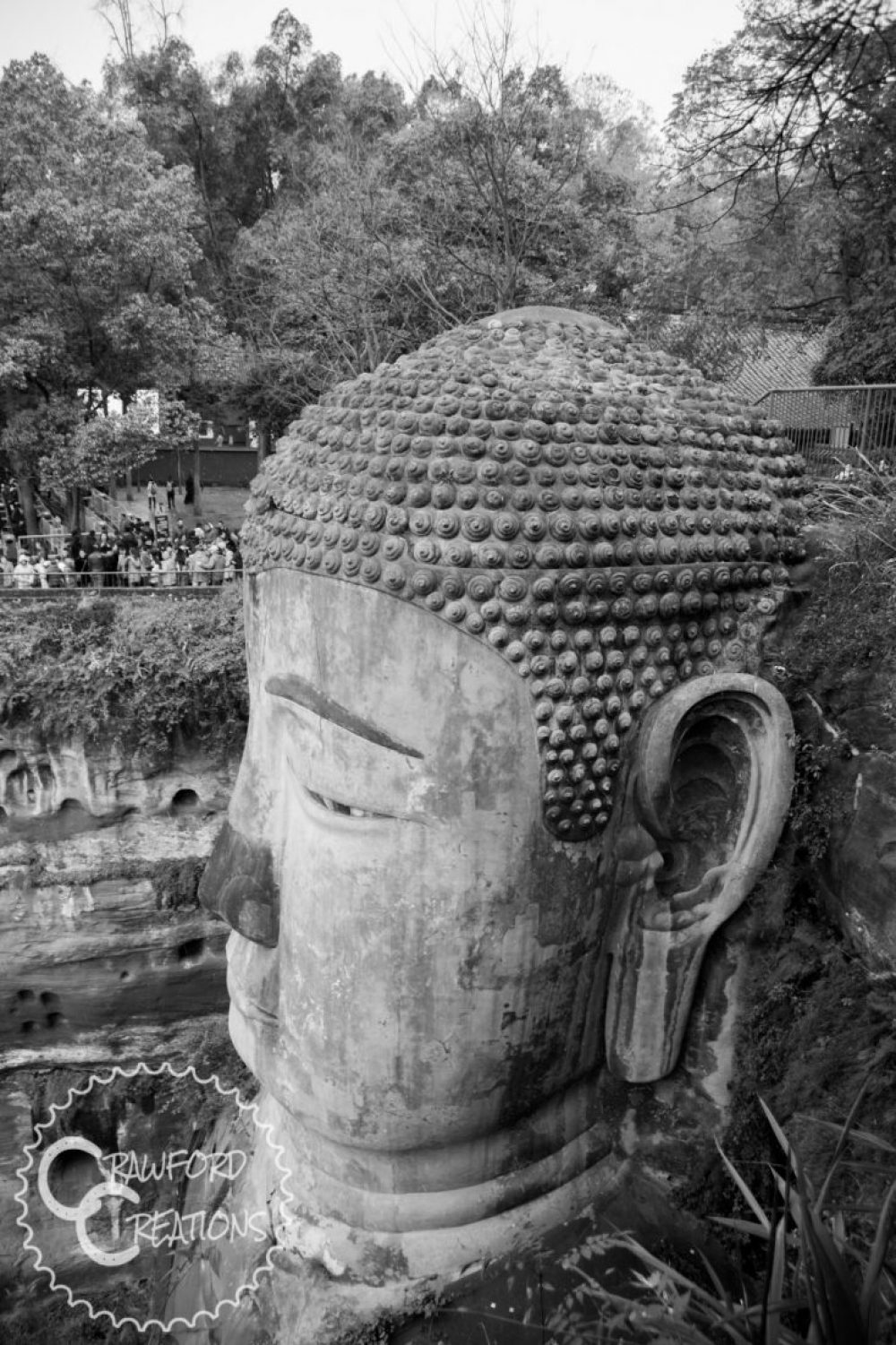Face to Face With The World’s Largest Buddha
***This post may contain affiliate links.***
The Giant Buddha in Leshan, a two hour bus ride away from Chengdu, was a must see on our trip. From Xiannanmen bus station in downtown Chengdu, we bought two one way tickets to Leshan. In China, you buy your tickets at the departing station, as a result, round trip tickets are a rarity, and if you can get them, the return ticket always costs more since you bought it at different station than the one you will be leaving from.
The general rule is to just buy a one way ticket to your destination, and then purchase a return ticket at the bus station once you have arrived. There are no concerns about getting stranded as even long distance buses in China, with the exception of really remote areas, leave every thirty minutes, so there are plenty of opportunities to get home at the end of the day.
The bus dropped us off at the Leshan bus station where we were immediately greeted by a nice woman shouting, in what I’m sure are the only English words she knows, “Bus to Buddha!” and ushers us into an unmarked van. Yes, I know that sounds creepy, but as there was a Buddhist monk passenger sitting in the van, we figured the ride was probably legit. These types of unmarked transportation can be seen all over China, and are completely safe, as well as hilariously either super cheap, or a gross rip off.
I have had great luck with any type of van. They are basically a combination of a bus and a taxi, in that they run only to set locations, but will take you wherever you need for an extra fee if you ask. They will almost always wait until the van is full before leaving, which is a good thing, as a full van will only set you back 5rmb, whereas an empty van will cost you 50rmb. Our van filled up, and off we went, 15-20 minutes down the road to the entrance of the Leshan Giant Buddha Scenic Area. There are four entrances to the park, as we later found out, so make sure you know which one you entered at if you need to depart from the same spot later in the day.

There are two separate tickets you can buy: a ticket just to see the acclaimed “Giant Buddha”, and a second ticket giving you access to the surrounding park. Buy both, as the park, to me, was just as amazing as the “Giant Buddha” itself with the absence of the crowds. There are actually about 3 giant Buddhas in total in the scenic area, it’s just that THE giant Buddha is the giantest of them all, but let me tell you, the others are not much shorter.
The giant Buddha scenic area is a wonderous maze of caves, all decked out in intricate carvings, the walls lined with statues of different gods and goddesses as well as marvelous depictions of ancient scenes. The first giant Buddha we came to was jaw dropping to say the least. A spectacular stone carving tens of meters tall of a seated Buddha with a swastika emblazoned on his chest, the Buddhist symbol of peace (not the Nazi symbol of evil as most people associate it).
It was mind blowing how the ancient Buddhists were able to create such a ginormous and magnificent statue out of a cave wall on the inside of a mountain. Giant Buddha number two was even taller than the first, a fantastically carved floor to ceiling statue of a Buddha standing straight up, arms by his sides. The scale on these statues was just amazing, and I couldn’t believe that we hadn’t even made it to the acclaimed, Giant Buddha yet.

Once outside the caves, we walked up the mountain over many, many staircases, along which were landings with temples perched on top housing beautiful Buddhist shrines lined with prayer mats. At the top lay the entrance to the official Giant Buddha. We walked through the gate, handing our tickets to the guard, and were almost immediately greeted by a throng of people (I was wondering when our Chinese experience was about to begin).
Our first view of the Buddha was his head, alone, a mere 15 meters high. The observation deck puts you staring almost eye to eye with the 71 meter tall Buddha, every detail of the serene expression on his face carved out and his hair meticulously arranged in 1,021 black buns. Walking around to the other side of his 28 meter long shoulders was the queue in which we spent our 45 minute wait time in order to walk down the stairs to ground level.
The stairs were jam packed with people, and for as long as we waited in line during the off-season, I can’t imagine what this place is like during peak travel. The good thing was that with stairs that steep, and that many people, you were guaranteed to always have a nice cushion to fall on if you happen to misstep, as I reassured my friend many times during our wait.

It was a very slow descent, amid hundreds of our very “closest” friends, and I was certainly wishing I had Justin’s height advantage at times to take pictures over other peoples’ heads, but it was such a cool experience, and even without the height I was able to snap some nice photos to capture the moment.
At the bottom, you really get to fully appreciate just how tall this thing is. Carved into the cliff of a mountain, the Giant Buddha towers above the convergence of the Minjian, Dadu, and Qingyi rivers, and is an absolutely spectacular work of art. The carving began in the year 713 during the Tang Dynasty, and the work was conceived by the Buddhist monk Hai Tong. Hai Tong was deeply troubled by the suffering of so many of his people, who were either injured or killed by the turbulent waters of the river.
The people attributed the disaster to the presence of the water spirit, and thus Hai Tong set about carving the Buddha in the hopes that he could calm the water and make it safer for the people cross in their boats. The project took 90 years to complete, and it is said that afterwards, due to the amount of rock deposited into the river during the creation of the Giant Buddha, the river currents had changed, and it was indeed much safer for the people to travel on.
To this day the Buddha sits peacefully overlooking the river, soothing the water spirit as well as the spirits of all those tourists who come to look in awe, and pay their respects to the almighty Buddha.

For more photos of the ancient cultural and architectural marvels within the Leshan Giant Buddha Scenic Area check out our gallery: Leshan Giant Buddha.
WANT TO TRAVEL CHEAPER & EASIER?
Subscribe to follow our blog and be the first to read our new posts!
Success! Happy dance optional :) P.S. check your inbox for goodies!
*** This post may contain affiliate links. By purchasing a product or service through these links you are helping to support this blog at no extra cost to you! We only recommend products we personally use and love! ***


 Hey, we're Cara and Justin, the adventure travel loving couple behind Crawford Creations. We're here to help you travel the world independently, save money on your travels, and discover off the beaten path destinations along the way. Click the About tab to find out more!
Hey, we're Cara and Justin, the adventure travel loving couple behind Crawford Creations. We're here to help you travel the world independently, save money on your travels, and discover off the beaten path destinations along the way. Click the About tab to find out more!



Comments